|

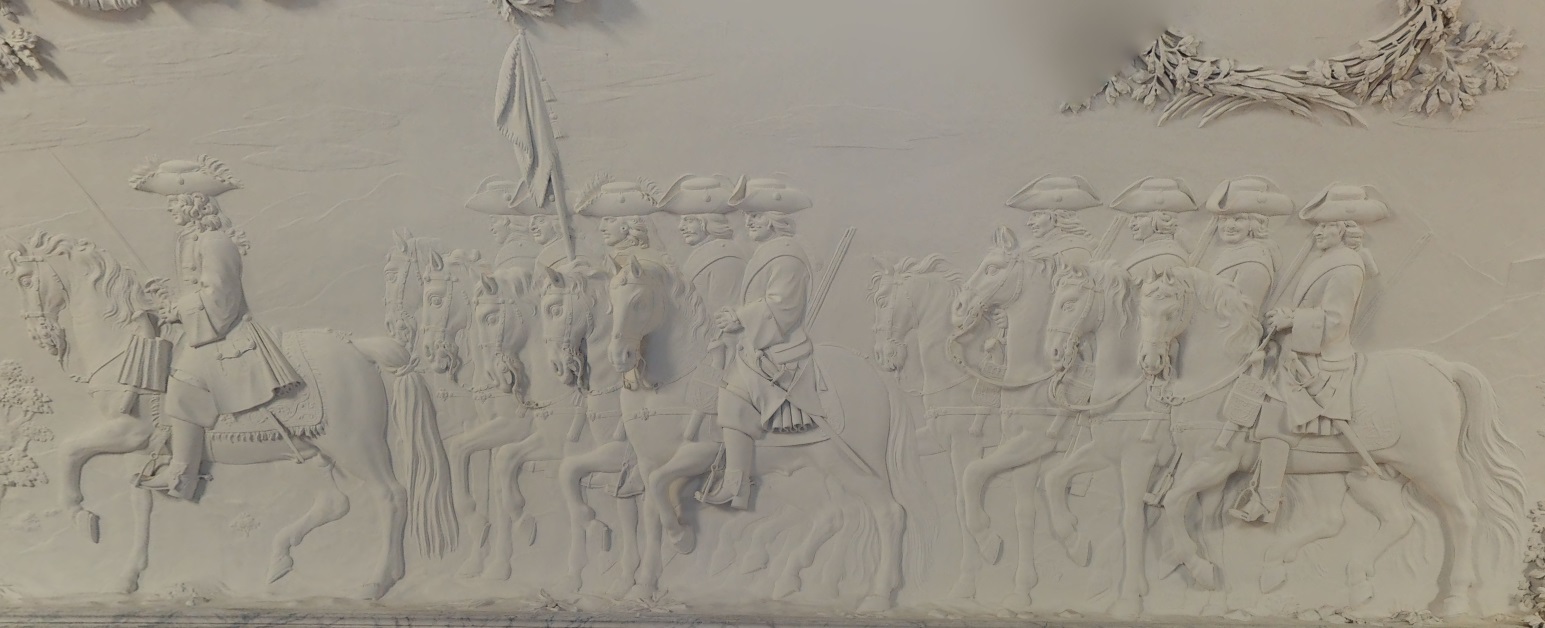
National dragoons (conscripts) depicted in 1704-1706
on a relief in Rosenborg castle (close ups are available
at the bottom of this page).
The Danish cavalry had the same
cut and colours on their coats as the infantry. But apart from the regular coat
the cavalry man also had a buff coat made from elk skin and it was this
clothing they usually wore in combat. From 1707 they also wore a black
cuirass (although only with a front plate). Some regiments such as Livgarden til Hest (Horse
Guards) and 1st Jyske had worn cuirasses even before 1707. Another
difference from the infantry was that cavalry officers until 1708 (when it
was forbidden) had reversed colours on their coats compared to the privates.
If for example the privates had red
coats with blue facings then the officers had blue coats with red facings.
The cavalry men's vests and
breeches were normally made of yellowish leather. The hats had silver lace and
an iron skull cap inside to protect the head. When the army shifted to red coats 1711
it was also decided that the saddle cloth should be red with edges in the same
colour as the coat's lining.
Officers had as distinctions a
sash and also silver and gold lace on their hat, saddle cloths and belts.
Unlike the privates they were not armed with carbines.
The dragoons were considered
to be mounted infantry and as such they did not have buff coats, cuirasses or
a skull caps in the hat.
On the other hand they ha grenadiers in their ranks which could have had
special grenadier caps.
|
|
Livgarden
til Hest
(Horse Guards)
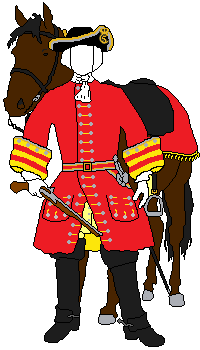 |
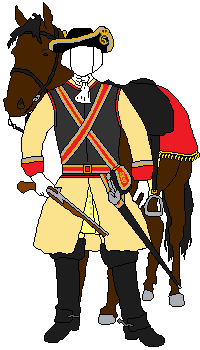 |
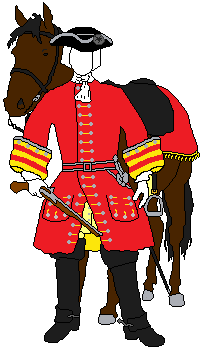 |
 |
|
1686- |
-1707 |
|
Red coat with 60 silver buttons and yellow lining,
red-yellow-striped velvet cuffs laced with gold and silver. Red
cassock with 11 dozen (!) buttons covered with silver and aurora,
yellow lining and collar, and on both sides the royal coat of arms
embroidered in gold and silver. Hat with gold and silver lace, the
king's gilded monogram and tassel. Belts covered with red
velvet and gold and silver lace. Red shabraque and pistol covers
with yellow fringes, embroidered edge and the royal
monogram. The buff coat had red velvet cuffs and a wide gold and silver
lace halo |
In 1692 the buff coat had silver buttons and red cuffs
with silver lace (had all gold lace disappeared by this
time?). The cassock (not pictured above) had the royal coat of arms
embroidered on both sides in 1699. In 1703 they had a tricorne hat
with a black cockade. |
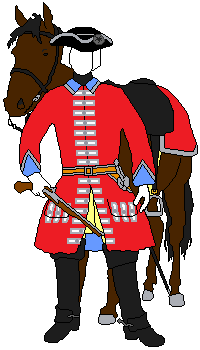 |
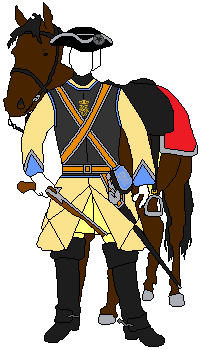 |
 |
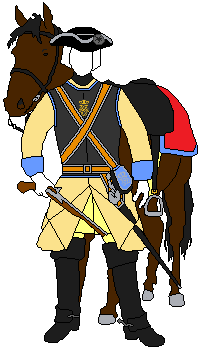 |
|
1708-1710 |
1710-1721 |
|
Crimson
coat with blue (bleumerant) lining, cuffs and collar. Silver lace on
the collar. Two dozen pewter buttons and 44 "sløjfer" and
two round lapels (all consisting of 20 ¼ elle of silver lace.
Buff coat with blue cuffs, leather breeches, black neckcloth. Hat with
silver lace and black cockade. Crimson coat with blue lining and
blue collar with silver lace. Cartridge box lid covered with
blue cloth and decorated with silver lace and silver embroidery
Black painted cuirass edged with blue lining and decorated with the
King's gilded monogram. Crimson shabraque edged with silver lace. |
Madder red
coat and cloak with blue lining. The coat would now have the same
design as the rest of the army. Blue cuffs without silver lace.
Madder red shabraque with camel hair edge (white according to Karsten Skjold Petersen but light blue according to Snorrason and
Höglund). Cuirass with royal monogram. |
|
|
Livregiment til Hest
(Life Regiment on Horse)
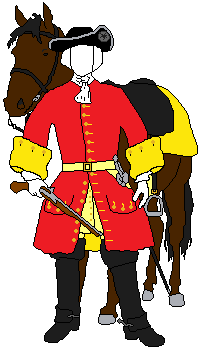
1699 |

1701-1714 |
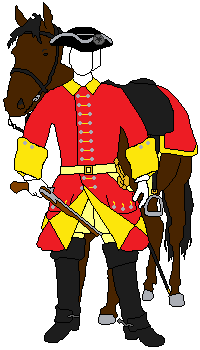
1714-1722 |

Buff coat |
|
Red coat
with yellow cuffs and lining. |
Was in
Dutch service during the War of the Spanish Succession and had red
coats when it returned to Denmark in 1714. |
Red coat
with yellow cuffs and lining. |
Cuirasses
decorated with the king's crowned monogram were issued in 1709. |
Before 1699 the Livregiment had grey coats with red lining, but the
uniform regulation from this year called for red coats with yellow
lining. In 1710
were the NCOs issued coats edged with silver lace. |
|
1. Sjællandske
(First Zealand)
|
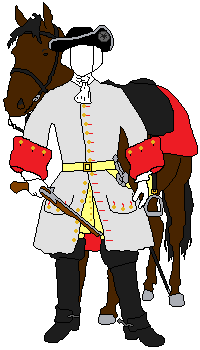
1695 & 1700 |
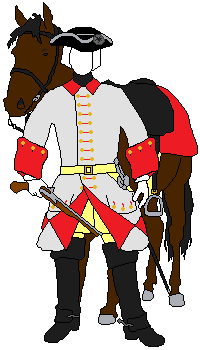
1709 |
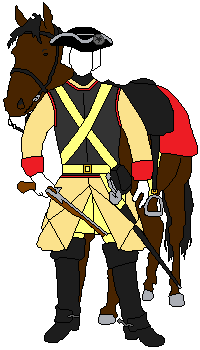
Buff coat before m/1711 |
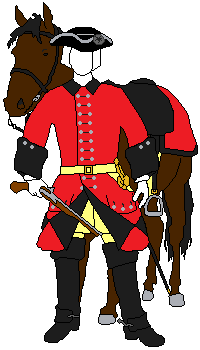
m/1711 & m/1716 |
|
1695 light
grey coat with crimson lining and cuffs. Drabant Olof Stiernhöök wrote
on 19 August 1700 in his diary that the regiment had coats that were "white
with red lining". |
Postmaster
Carsten Olofsson in Malmö wrote on 10 December 1709 that the regiment
had "white coats and cloaks, as well as red cuffs and collars". |
|
Red coatt with black cuffs and lininng. |
|
|
2. Sjællandske
(Second Zealand)
|
|
3.
Sjællandske
(Third Zealand, 2. Sjællandske from 1714)
|

1695 & 1700 |

1709-1712 ? |
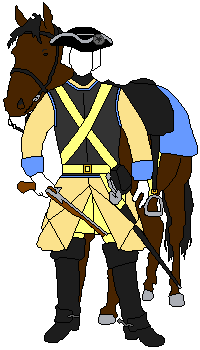
Buff coat before m/1711 |

m/1711 & m/1716 |
|
1695 light
gray coat with sky blue lining and cuffs. Drabant Olof Stiernhöök wrote
on 19 August 1700 in his diary that the regiment had coats that were
"white with blue lining". |
Red coat with yellow
and black cuffs, and yellow lining. |
|
|
1.
Jyske
(First Jutland)
|
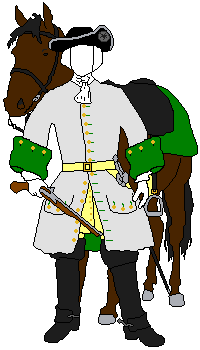
1695 |
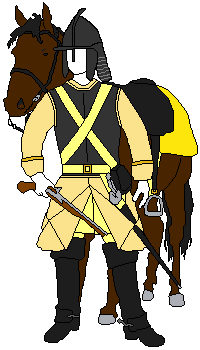
1702 |
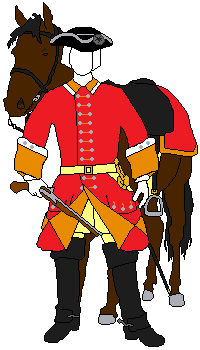
m/1711 |
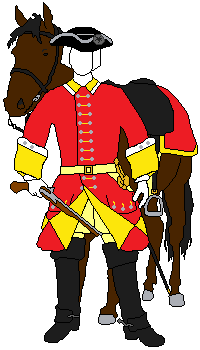
m/1716 |
|
Light grey
coat with grass green lining and cuffs. Had in 1702 a hat with wide silver
lace and black cockade. |
Helmet (also hat) and buff coat with leather
cuffs embroidered with gold. Yellow standards were issued in
1706, which may indicate that the green colour from 1695 was no longer
the regimental colour. |
Red coat with cuffs and lining in feuille morte. The cuffs would also
have a white stripe. |
The regimental colour changes to yellow. There are different descriptions on how the white
stripe should be placed. The image follows the plate from 1716
but Daniel Schorr has the stripe in the middle of the cuffs.
Another plate from 1730 has two stripes on the cuffs. |
The regiment had served in foreign auxiliary corps 1692-1699
and on their return received special permission to continue to wear the
full cuirass they had acquired during this time. That is, cuirasses that
covered both the front and the back as well as helmets and perhaps also protection on
the arms and legs. Until at least the Scanian campaign of 1709-1710, the
regiment seems to have distinguished itself by having extra armour
judging by eyewitness reports. The English envoy Vrigny was present when
the regiment was mustered on 21 June 1702 and described it as follows:
On the 21st the King inspected the cuirassier regiment belonging to Colonel Legard on a
large plain where Kolding’s highest hill is located. This regiment is regarded as the most
handsome in Denmark and returned home two years ago from Hungary. There the
regiment took part in 9 campaigns without a pause. The regiment was clothed in cuirass
over buff coats. Leather cuffs (that is uncoloured cuffs?) were embroidered with gold,
likewise the gauntlets. Helmets were not worn because of the cold. Instead, the
cavalrymen wore hats with a wide silver lace and a black cockade. I saw a few of the
officers’ helmets with handsome feathers. These helmets were carried by the officers’
servants. It must be impressive when the whole regiment is attired in their armament and
all with helmets. There are in all 6 companies each of 60 men, all clothed in buff coats
with breastplate fastened with belts on the back. All of the belts are supplied with iron
scales. Officers and non-commissioned officers wear the full cuirass. All had large
moustaches. The horses were all of different colours, except for one company where all of
the horses were black. As distinction the non-commissioned officers has silver
embroidery, while officers had gold embroidery and feathers on the
helmet.
In the spy
report from the Malmö postmaster Carsten Olofsson on 10 December
1709, the First Jutland was the only cavalry regiment he called a "cuirassier
regiment". The uniform was described only as "white livery". It was the only regiment that he did not mention the colour of cuffs
and collar. |
|
2.
Jyske
(Second Jutland)
|
|
3.
Jyske
(Third Jutland)
|
 |
 |
 |
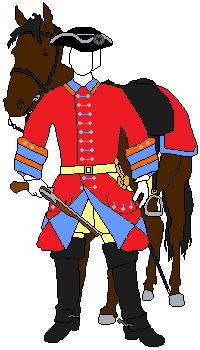 |
|
1695 |
1714-1716 |
1716-1721 |
|
Grey coat, light brown
cuffs and lining according to Skjold Petersen and feuille
morte according to Snorrason. |
Red coat
with dark green cuffs and lining (according to m//1711, they should
actually have blue regimental colour and an aurora-coloured stripe on the
cuffs). |
Red coat with
light blue lining and light blue cuffs with two aurora coloured stripes
(m/1716). |
Was
in English service during the War of the Spanish Succession 1701-1713. |
|
4. Jyske
(Fourth Jutland)
|
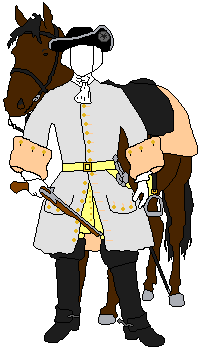 |
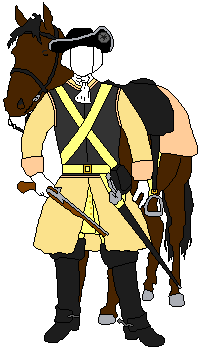 |

1701-1714 |
|
1695 |
|
Grey coat with lining and turnout coloured isabella. |
Was in Dutch
service during the War of the Spanish Succession and disbanded on return
to Denmark in 1714. |
|
|
5. Jyske
(Fifth Jutland, 4. Jyske from 1714)
|

1695 |

1701-1714 |
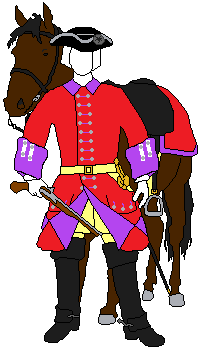 |
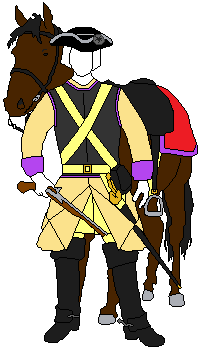 |
|
1714-1722 |
|
Grey coat with yellow lining and cuffs. |
Was in Dutch
service during the War of the Spanish Succession. |
Red coat with violet lining and violet
cuffs with white lace. |
|
|
1.
Fynske
(First Funen)
|
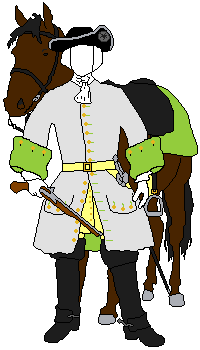
1695 |
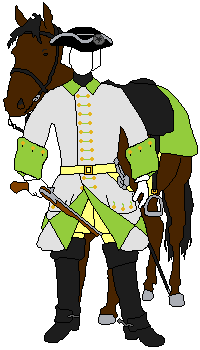
1705-1706 |
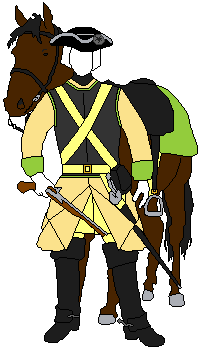
Buff coat before m/1711
|

m/1711 & m/1716 |
|
Light grey coat with light green lining
and cuffs. |
Red coat with
dark green lining. Cuffs and collar dark green with white stripe. |
|
|
2. Fynske
(Second Funen)

1695 |
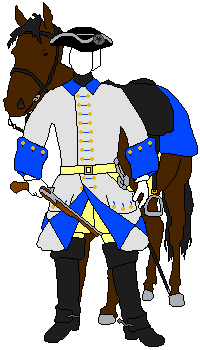 |
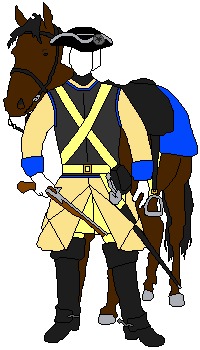 |
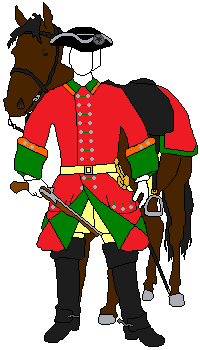
m/1711 & m/1716 |
|
1709 |
|
Light grey coat with orange lining and cuffs. |
According to a Swedish spy report: "white coats and
cloaks, blue cuffs and collars" |
Red coat,
green lining,
green and aurora coloured cuffs. |
There are different descriptions of what the m/1711 and m/1716 uniforms'
cuffs looked like. |
|
Holstein
Cuirassier Regiment
(Oldenborgske until 1702)
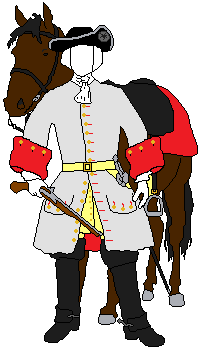
1685 & 1695 |

1701-1713 |
 |
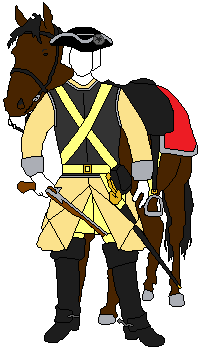 |
|
1714-1721 |
|
Light grey
coat with red lining and cuffs. |
Was in English
service during the War of the Spanish Succession. |
Red coat with steel grey lining and cuffs. |
In
1699 the regiment is stated to have had grey coats and "otherwise like
the Livregiment". |
Württemberg Cuirassier Regiment
(Ahlefeldt's Cuirassier Regiment until 1705)
|
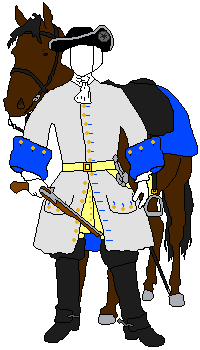
1700? |

1701-1713 |
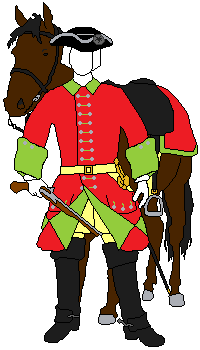 |
 |
|
1714-1721 |
|
Skjold
Petersen, Snorrason and Höglund all mention that the uniform before 1714
is unknown, but Höglund writes that the regimental colour was possibly
medium blue. |
Was in
English service during the War of the Spanish Succession. |
Red coat with light green lining and cuffs. |
Torstein Snorrason writes that an officer in the regiment with the
rank of cornet wore a buff coat with gold and silver lace and cuirass.
The shabraque had gold lacce. But the cornets did not have a sash
as a sign of dignity, unlike the staff officers who had
gold-embroidered silk ones. |
|
"Hungarian"
Cuirassier Regiment
(Was actually named after its colonels, 1709-1717 it was Dewitz)
|
 |
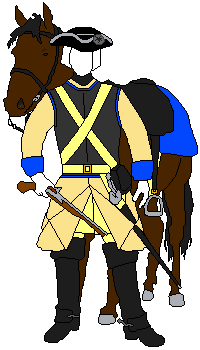 |

m/1711 |
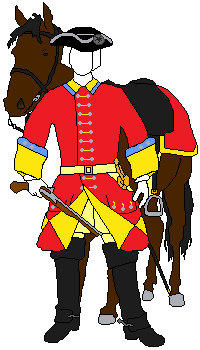
m/1716 |
|
1709 |
|
Light grey
coat with blue lining and cuffs. |
Red coat with
steel grey lining and steel grey cuffs with white lace. |
Red coat with
yellow lining and yellow cuffs with light blue stripes. |
According to
Torstein Snorrason, the enlistment patent from 1701 is said to have
determined that the regiment would have grey-white coats and cloaks with
blue lining and blue cuffs, as well as leather vests and leather
breeches. But the enlistment patent does not remain in original, but
this information comes from a specification from 1709.
Lars-Eric Höglund
writes on the other hand the regiment had in 1709 "red coat with steel
green collar ". This information probably comes from Vaupell and "steel
green" is with him a common misspelling for "steel grey" which is due to
the fact that the publishers had difficulty reading his handwriting. The
year also appears to be a mix-up with the above-mentioned enlistment
patent and the 1711 regulation stipulating that the regiment was to have
red coats with steel gray lining and steel grey facings with white lace along
the buttons.
Both Höglund and Schorr
say that the regulation from 1716 prescribes a red coat with blue
lining and yellow cuffs with a blue stripe. Although Höglund also
mentions that there is other information which says that the coat had a
yellow collar and lining. Karsten Skjold Petersen also stated in the
book from 2005 that the lining was either blue or yellow, but in the
book from 2014 he only writes that the lining was yellow. Unlike the
others who only indicate one stripe on each cuff, Skjold Petersen has
written that the cuffs had two stripes. He phrased it vaguely
in the first book about the time period that the cuffs looked like
that ("?-1722-?") but more specifically in the second book
("1716-1734"). The plate from 1716, however, shows only one stripe. |
|
Brockdorff's Cuirassier regiment
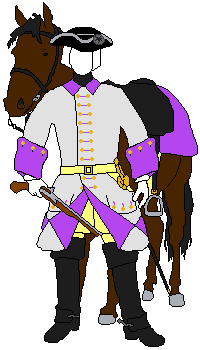 |
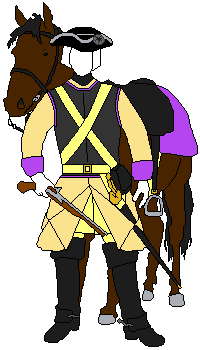 |
 |
 |
|
1710 |
m/1711 |
|
Grey-white coat, leather vest,
leather breeches and cuirass |
Red coat with violet lining and
violet cuffs with white lace. |
This regiment was raised in 1710 and disbanded due
to poor conduct during the Battle of Gadebusch in 1712. It is very
doubtful if the m/1711 uniform was issued. However for the uniform
issued in 1710 the regimental colour is not mentioned so I have only
guessed it was the same colour as m/1711. |
|
Livregiment
Dragoner
(Life Dragoon Regiment)
|
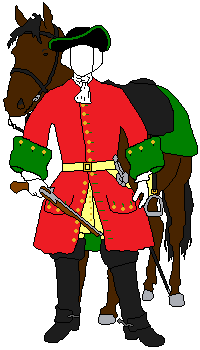
Holstein Dragoons
1685-1701? |
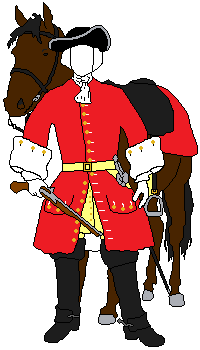
Life Dragoons
1691-1702 |
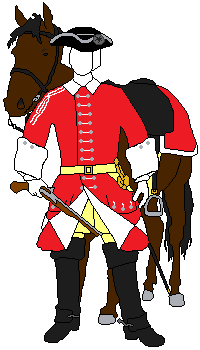
Life Dragoons
1708-1718 |

Life Dragoons
1720-1731 |
|
Red coat
with green lining and cuffs
The
regiment was merged with the Life Dragoons in 1701. Only Höglund
mentions its uniforms (without specifying the year). |
Red coat with white
lining and cuffs. The coat colour was crimson in 1695.
In 1704 the Life Dragoons were to have crimson shabraques and pistol
covers. In 1706 the King granted them a cockade on their hats |
Crimson
coat with collar and cuffs of white cloth and lining of white baize.
Shoulder cords on the coat from 1708 (which the regiment had to
pay for itself).
Due to a
lack of white cloth, the cloak received a red collar in 1708. |
Red coat
with a single row of buttons (since 1718). Cuffs, lining, vest
and breeches white. The cockade may have been abolished in 1721. |
About
the life dragoons, Höglund writes (without specifying the year) that
they had hats with silver lace and black cockades. Their coat was
crimson with white cuffs and lining. The grenadiers had fur caps with
the front flap embroidered in silver.
The postmaster Carsten Olofsson in Malmö reported
in 1709 that the life dragoons, which he called Rodsten's dragoon regiment, had
"Red coats and cloaks with white cuffs and collars". |
|
"Hungarian" Dragoon Regiment
(Got its name after the return from Imperial service in 1709. Was actually
named after its colonels)
|

Before 1709? |

1709 |

After 1709? |

m/1711 |
|
Blue
cuffs and lining on 28 October 1700. Was in Imperial service
1701-1709 and according to Snorrason the coats are described in
sources as yellow with blue cuffs or blue with yellow cuffs
(cloak with reversed colours?). But grey coats with orange are also
mentioned.
According to Höglund, the coat in 1700 was red with
blue cuffs and lining, but in 1703 yellow with light blue lining
and in 1709 blue or grey with orange cuffs and lining. |
The
postmaster in Malmö reported on 10 December 1709: that the regiment
had "Red coats and cloaks with blue cuffs and collars".
The king
had granted new vests and breeches of leather in October 1709,
After complaints about the condition of the uniforms, "almost naked
and worn out", the king granted money for new coats, cloaks,
saddles, shabraques and swords on 7 December 1709.
|
According
to a July 1709 specification, the regiment was to be provided with
blue coats with orange lining and cuffs when returning home
after being in Imperial service in 1701-1709. Skjold Petersen
considers it likely that the last uniform of the Hungarian dragoons
before its dissolution in 1714 had this colour combination (page 679,
note 304). However, he states grey coat with orange cuffs & lining
1709-1714 on page 615. |
Red coat
with aurora coloured lining and cuffs in aurora and white. Neither
Skjold Petersen nor Snorrason believe that this uniform was
issued before the regiment was disbanded in 1714.
The
colonel complained about the m/1711 uniform because he had been
given blue coats and shabraques that would last for two years. He
therefore wanted dark blue lining and cuffs instead. He also
suggested that the old coats could be used to make vests. |
This was originally two dragoon regiments under
the command of Rodsten and Juel which were leased to the Emperor in 1701
and in 1703 merged into one regiment after they had suffered heavy
losses in northern Italy. It then fought in Hungary until it returned to
Denmark in 1709 under Bülow's command. While in foreign service it was
given Austrian equipment (which it kept even after returning
home) and the recruitment was done on location so that it consisted
almost exclusively of Hungarians and Germans. The regiment was disbanded
in 1714 and the majority of the men were put into the Württemberg
Dragoon Regiment. At this time, the Danish proportion of privates in the
Hungarian dragoon regiment was still as low as 4% (the average for
Danish cavalry regiments was 29%).
Since the regiment was mostly Hungarian, Torstein
Snorrason has made the assumption that the regiment wore traditional
Hungarian caps instead of the tricorne hats that I have depicted
them wearing. Torstein Snorrason also argues that the regiment had red
coats with blue cuffs in Danish service by referring to the
postmaster's report from 1709 as well as an epitaph on von Pottendorf
who fell in 1711 and who is depicted in a red coat and with red pistol
covers with gold fringe. Light blue cavalry standards and dragoon
colours are also visible in the image (the dragoon regiment claimed the rank
of a cavalry regiment). Höglund mentions that the company colours were
stated in 1712 to have been light blue with stars. |
|
Württemberg-Oels
Dragoon Regiment

1701 |

1702 |

1703-1714 |

1714-1721 |
|
The enlistment
patent states blue coat with red cuffs. |
The English
envoy Vrigny described the uniform as "white with yellow cuffs". |
Was in English
and Dutch service during the War of the Spanish Succession. |
Red coat with
cuffs and lining in aurora (m/1716). |
Torstein Snorrason believes that Vrigny misunderstood
the name of the regiment he saw in 1702 and was in fact describing Prince
Carl's infantry regiment which was also stationed in Holstein. Lars-Eric
Höglund has made the interpretation that the white/yellow coats were a
temporary uniform that was worn before they got the regular uniform. |
|
Sjælland-Fynske landragoner
(Zealand-Funen National Dragoons)
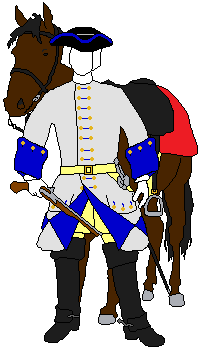
1704 |
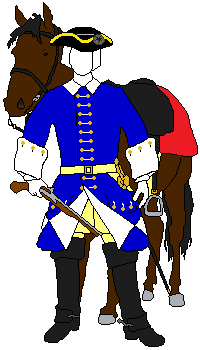
1707 |
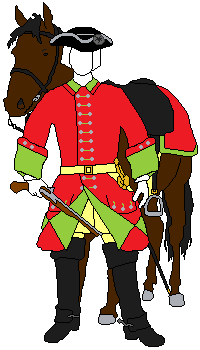 |
 |
|
m/1711 & m/1716 |
|
Light grey
"vadmal" coat with blue lining and cuffs. Leather vest and
leather trousers. Hat with lace. According to Snorrason, the
shabraques seem to have been red. |
The
national dragoons were to have a blue coat with cuffs and collar
in the regimental colour. Yellow buttons and edged buttonholes. Hat
with lace and black cockade. White neckcloth, blue cloak and leather
breeches. A Swedish spy report from 1709 states "blue coats and
cloaks, as well as white cuffs and collars". |
Red coat with light green lining
and light green and red cuffs.
Converted to an
enlisted cuirassier regiment on 9 March 1711. The uniform regulation
of 24 October 1711 states that the regiment already had the m/1711
uniform. It may therefore have been issued when the regiment was
converted to cuirassiers. |
|
|
Jyske landdragoner
(Jutland National Dragoons)
|
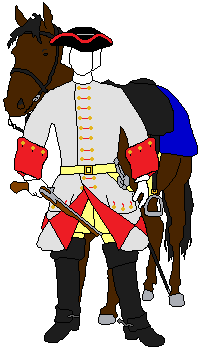
1704 |
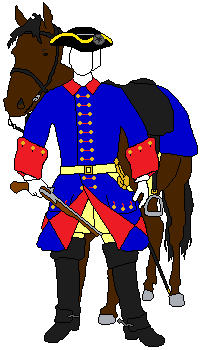
1707 |
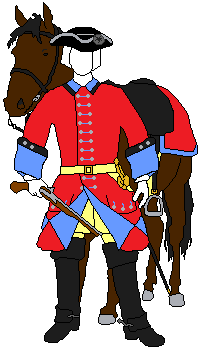 |
 |
|
m/1711 & m/1716 |
|
Light grey
"vadmal" coat with red cuffs. Leather vest and leather trousers. Hat with
lace. According to Snorrason, the shabraques seems to have been blue. |
The national
dragoons were to have a blue coat with cuffs and collar in the
regimental colour. Yellow buttons and edged buttonholes. Hat with lace and
black cockade. White neckcloth, blue cloak and leather breeches. |
Red coat with light blue lining and
light blue and black cuffs.
Converted to an
enlisted cuirassier regiment on 15 December 1710 and then received new
hats with silver lace. |
|
|
National Dragoons Raised in 1717
(disbanded in 1730)
|

East Sjællandske
1722-1730 |
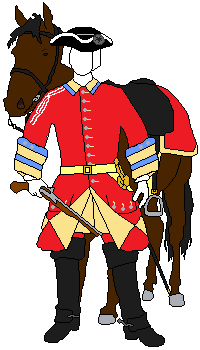
West Sjællandske
1722-1726 |
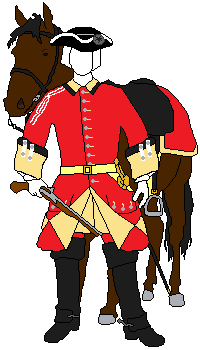
Jyske-Fynske
1722-1730 |
|
Red coat
with blue lining, blue cuffs with orange stripe and white lace, and
paille yellow vest. Hsd in 1730 red breeches and white
buttons.
According
to Skjold Petersen, the cuffs were blue in 1720. In the book from
2005, he also had different information than the one from 2014. Then
he wrote that the cuffs had a paille-coloured stripe "1722-?"
and black & white stripes "(1728)-1730".
According
to Höglund, in 1717 they had a red coat with a light blue collar and
a wide white edge. |
Red coat
with paille yellow lining, paille yellow cuffs with two light
blue stripes (only one red stripe 1726-1730) and paille yellow vest.
Red breeches.
According
to Skjold Petersen, the cuffs were yellow in 1720. In the book from
2005, he also had different information than the one from 2014. Then
he wrote that the cuffs and vest were orange in 1722 instead of
paille, but he stated that the cuffs and lining were paille in 1729.
According
to Höglund, in 1717 they had a red coat with a light yellow collar
and a red/white edge. |
Red coat
with paille yellow lining, paille yellow cuffs with black stripe and
white lace, and paille yellow vest.
According
to Skjold Petersen, the cuffs were paille yellow in 1720. In the
book from 2005, he also had different information than the one from
2014. Then he wrote that the cuffs had a light blue stripe in 1722
and black and white stripes "?-1730".
According
to Höglund, in 1717 they had a red coat with a light brown collar
and black edge. |
If
nothing else is stated, the uniform information comes from Karsten
Skjold Petersen's book from 2014. Höglund's information is identical to
that found in Otto Vaupell's book (in that, however, no year is stated).
According to a regulation of January 1718, the dragoons were henceforth
to wear only single-breasted coats. They would also replace the leather
vest by re-sewing the old coat into a vest in the future.
However, the newly raised national dragoons seem to have been given
leather vests when the first uniforms were issued. Because just one
month after the regulation was declared, it was decided that East
Sjællandske should have leather vests. A new regulation from 1721
only mentions the lace and not the cockade on the hat which may
indicate that it had been abolished. Depictions of the national dragoons'
coats from 1730 reveal that they had shoulder cords similar to the life
dragoons.
|
|
Contemporary Depictions of National Dragoons 1704-1706
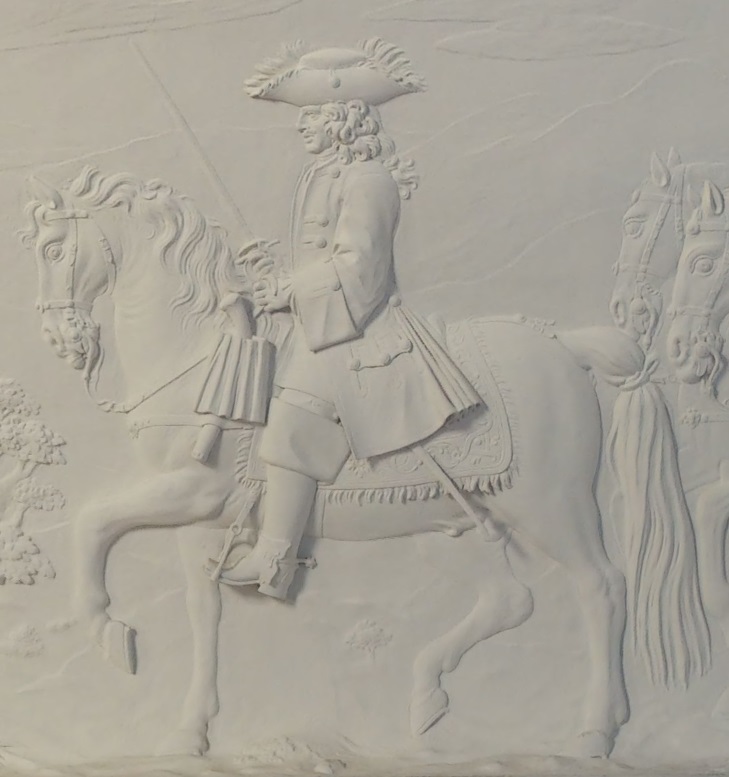
National dragoon officer, depicted 1704-1706 on a relief on the roof of the long hall in Rosenborg castle
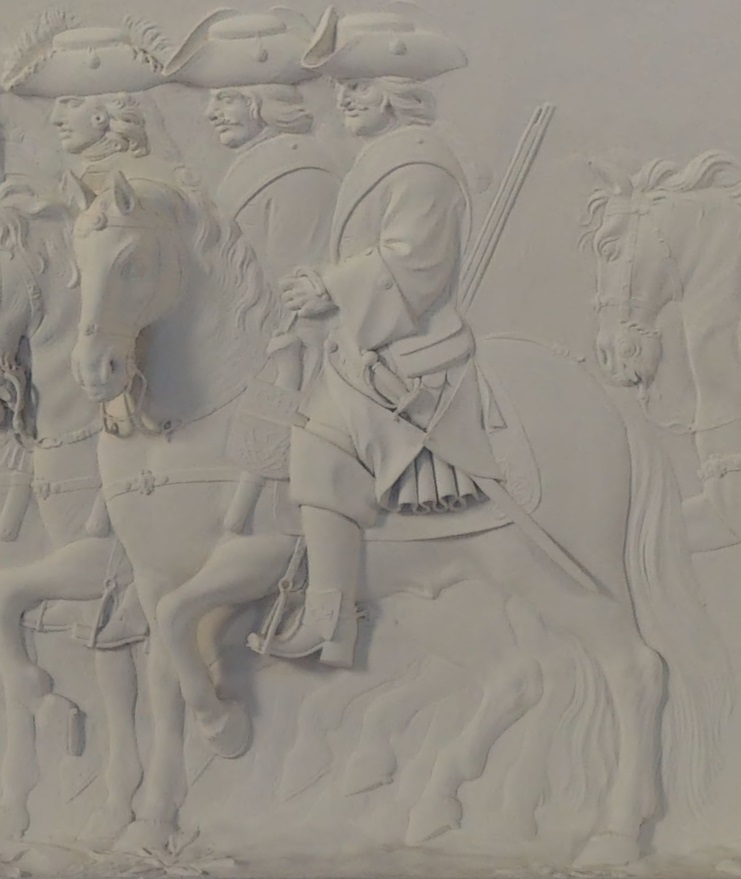
Private national dragoon, depicted 1704-1706 on a relief on the roof of the long hall in Rosenborg castle |
|
References
Höglund, Lars-Eric – Sallnäs, Åke. Stora nordiska kriget 1700-1721, II. Karlstad (2003)
Schorr, Daniel. Danish-Norwegian uniforms 1709-1720. *
Skjold Petersen, Karsten. Den danske hærs uniformer i 1700-tallet. Copenhagen (2005)
Skjold Petersen, Karsten. Kongens klæder. Copenhagen (2014)
Snorrason, Torstein. Bülow's "Ungarske (Hungarian)" Dragoon Regiment ca. 1710. *
Snorrason, Torstein. Danish Uniforms 1699-1712. *
Vaupell, Otto. Den danske hærs historie til nutiden og den norske hærs historie indtil 1814. Copenhagen (1872-1876)
* = articles published in 2008 on the now defunct website
www.northernwars.com |

